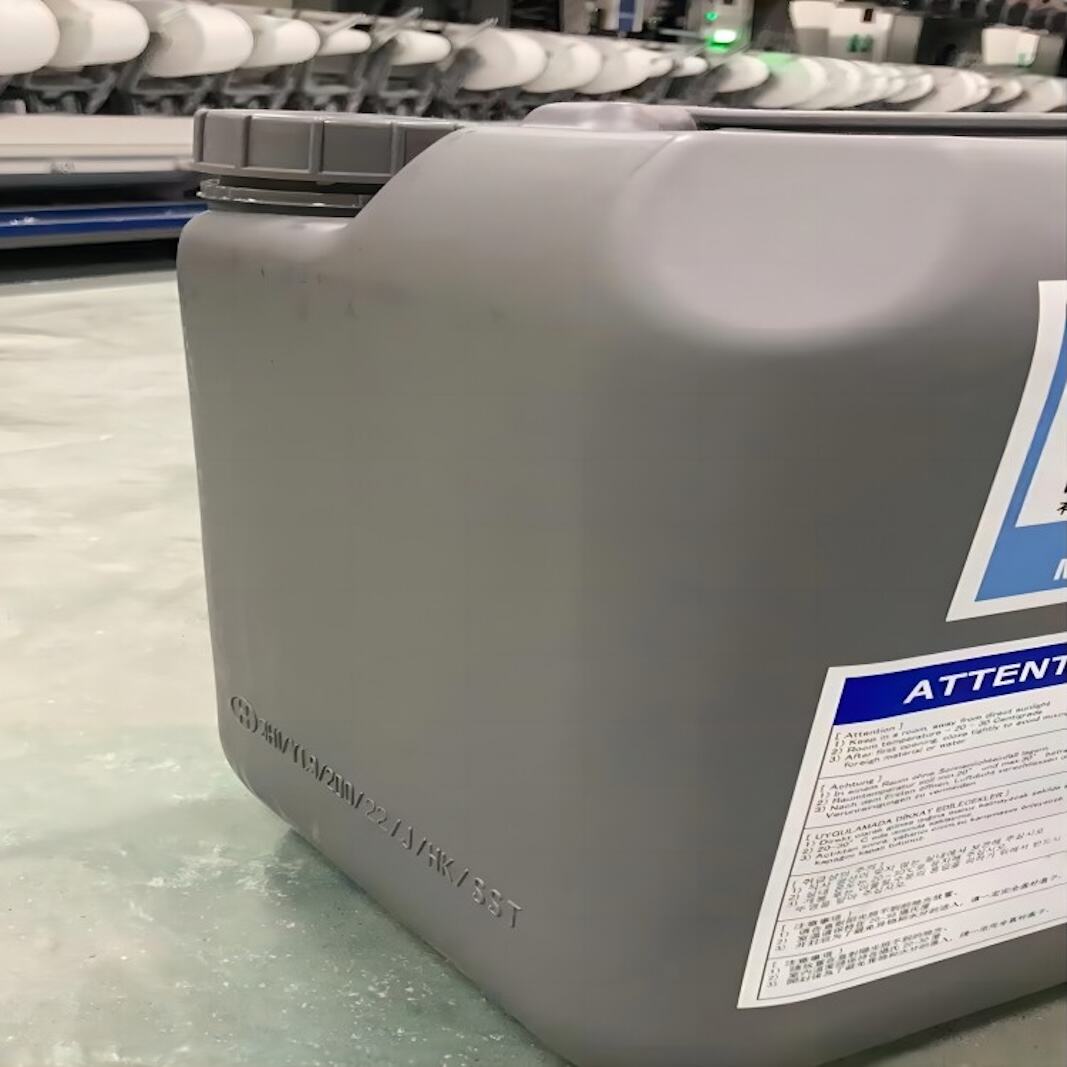บทนำ
น้ำมันมีความสำคัญอย่างยิ่งในกระบวนการผลิตสิ่งทอ ช่วยให้เส้นใยเคลื่อนผ่านเครื่องจักรได้อย่างราบรื่น และในที่สุดก็ได้ผ้าที่มีคุณภาพดีขึ้น ซึ่งเมื่อเปรียบเทียบน้ำมันที่มีอยู่หลากหลายประเภท น้ํามันหมุนหมุน ได้กลายเป็นตัวช่วยหลักในหลายกระบวนการปั่นเส้นด้าย เนื่องจากมีสูตรเฉพาะที่พัฒนาขึ้นมาโดยเฉพาะสำหรับการใช้งานนี้ โดยสำหรับผู้ผลิตสิ่งทอที่ต้องเผชิญกับกำไรที่จำกัด และข้อกำหนดที่เข้มงวด การใช้อุปกรณ์ให้เกิดประโยชน์สูงสุด พร้อมทั้งรักษาคุณภาพของเส้นใยไว้ คือสิ่งที่ทำให้เกิดความแตกต่างระหว่างกำไรกับขาดทุนบนพื้นโรงงาน
อะไรคือน้ำมันปั่นแบบ Vortex?
น้ํามันหมุนหมุน โดดเด่นในฐานะน้ำหล่อลื่นระดับพรีเมียมที่ออกแบบมาโดยเฉพาะเพื่อตอบสนองความต้องการของการดำเนินงานปั่นแบบวนรอบ (vortex spinning) สิ่งที่ทำให้มันแตกต่างจากน้ำมันปั่นทั่วไปคืออะไร? ผู้ผลิตได้ปรับสูตรของมันเพื่อลดแรงเสียดทาน ขณะเดียวกันก็เพิ่มประสิทธิภาพในการผลิตเส้นด้ายในกระบวนการความเร็วสูงเหล่านี้ ผลลัพธ์พูดแทนตัวเองได้เป็นอย่างดี เมื่อโรงงานสิ่งทอมีการเปลี่ยนมาใช้ผลิตภัณฑ์เฉพาะทางนี้ พวกเขาจะสังเกตเห็นการทำงานที่ราบรื่นขึ้นทั่วทั้งเครื่องจักร คุณภาพดีขึ้นเนื่องจากการสึกหรอระหว่างชิ้นส่วนลดลง นอกจากนี้ ทีมงานบำรุงรักษายังรายงานว่ามีการหยุดทำงานน้อยลงในแต่ละกะ ซึ่งหมายถึงผลผลิตโดยรวมที่ดีขึ้น สำหรับผู้ที่ใช้งานเครื่องปั่นแบบวนรอบอยู่ตลอดเวลา การรักษาเครื่องจักรให้ทำงานได้อย่างเต็มประสิทธิภาพจำเป็นต้องใช้น้ำหล่อลื่นที่เหนือกว่าของธรรมดา นั่นคือจุดที่ Vortex Spinning Oil เข้ามามีบทบาท ช่วยรักษาระดับความเร็วสูงที่จำเป็นต่อการผลิตเส้นด้ายอย่างสม่ำเสมอ โดยไม่กระทบต่อความทนทานหรือมาตรฐานการผลิต
น้ำมันหล่อลื่นแบบสปินนิ่งวอร์เทกซ์ ผลิตจากวัสดุสังเคราะห์และสารเติมแต่งจากธรรมชาติที่ถูกคัดสรรมาอย่างดี เพื่อให้ได้ผลลัพธ์ที่ยอดเยี่ยม องค์ประกอบหลักภายในมักจะประกอบด้วยสารต้านทานการสึกหรอ สารทำให้เกิดการกระจายตัวพิเศษ รวมถึงสิ่งที่เขาเรียกว่าตัวเสริมความเสถียร เมื่อผสมผสานเข้าด้วยกันอย่างเหมาะสมแล้ว ส่วนผสมต่างๆ เหล่านี้จะช่วยให้เครื่องจักรทำงานได้อย่างราบรื่น โดยไม่เกิดความเสียหายตามระยะเวลาการใช้งาน นอกจากนี้ยังช่วยให้น้ำมันมีความเสถียรแม้ในขณะที่หมุนด้วยความเร็วสูง ซึ่งมีความสำคัญมากในระหว่างการผลิตจริง ที่สำคัญที่สุด คือ การผสมผสานนี้ช่วยให้ผู้ผลิตได้เส้นด้ายคุณภาพดีขึ้น พร้อมลดข้อบกพร่องให้น้อยที่สุดตลอดกระบวนการทั้งหมด สำหรับผู้ที่จริงจังกับการผลิตผลิตภัณฑ์แบบวอร์เทกซ์สปินนิ่งระดับพรีเมียม การได้สัดส่วนที่เหมาะสมขององค์ประกอบเหล่านี้ไม่ใช่แค่เรื่องสำคัญ แต่เป็นสิ่งจำเป็นอย่างยิ่งต่อการได้ผลลัพธ์ที่สม่ำเสมอ
ประโยชน์ของน้ำมันสปินนิ่งแบบวนในกระบวนการผลิตเส้นใย
เมื่อใช้ผลิตภัณฑ์น้ำมันหล่อลื่นแบบวนรอบ (Vortex Spinning Oil) ผู้ผลิตสามารถเห็นคุณภาพของเส้นด้ายที่ดีขึ้น เนื่องจากน้ำมันช่วยลดแรงเสียดทานบนพื้นผิวขณะกระบวนการปั่นเส้นด้าย แรงเสียดทานที่ลดลงทำให้เส้นใยได้รับความเสียหายน้อยลง ดังนั้นเส้นด้ายที่ได้จึงมีพื้นผิวเรียบเนียนและมีความแข็งแรงมากยิ่งขึ้น ผู้ผลิตผ้าต่างชื่นชอบในคุณสมบัตินี้ เนื่องจากผลิตภัณฑ์สุดท้ายมีความนุ่มนวลต่อสัมผัสผิว และมีความทนทานมากขึ้นโดยรวม ผลการทดสอบจากอุตสาหกรรมแสดงให้เห็นว่าเหตุการณ์ขาดของเส้นด้ายลดลงอย่างมากเมื่อใช้น้ำมันพิเศษเหล่านี้อย่างเหมาะสม โรงงานผลิตสิ่งทอหลายแห่งรายงานว่า การหยุดเดินเครื่องเพื่อแก้ไขปัญหาเส้นด้ายขาดลดลง ตั้งแต่เปลี่ยนมาใช้เทคโนโลยีแบบวนรอบ น้ำมันนี้ทำหน้าที่เสมือนชั้นป้องกันระหว่างเส้นใย ช่วยให้เส้นใยจัดแนวได้ดีตลอดทั้งกระบวนการผลิต ตั้งแต่ต้นจนจบกระบวนการ
น้ำมันหล่อลื่นแบบหมุนวนมีความสำคัญอย่างมากเมื่อต้องการผลิตเส้นใยได้มากขึ้น เมื่อเครื่องจักรทำงานได้ลื่นไหลยิ่งขึ้นในระหว่างกระบวนการปั่นเส้นด้าย โรงงานสามารถผลิตสินค้าได้มากขึ้นพร้อมทั้งลดเวลาที่ต้องใช้ในการซ่อมแซมและบำรุงรักษา สิ่งที่ทำให้น้ำมันชนิดนี้โดดเด่นคือประสิทธิภาพในการหล่อลื่นชิ้นส่วนต่างๆ ของเครื่องจักรได้อย่างทั่วถึง โรงงานทอผ้าที่เปลี่ยนมาใช้น้ำมัน Vortex มักพบว่าอุปกรณ์มีอายุการใช้งานที่ยาวนานขึ้นระหว่างการเกิดความเสียหาย สำหรับผู้ที่ดำเนินธุรกิจด้านสิ่งทอ สิ่งดีๆ เหล่านี้นำมาซึ่งการประหยัดค่าใช้จ่ายที่แท้จริงในระยะยาว ผู้ผลิตที่ต้องการลดต้นทุนโดยไม่สูญเสียคุณภาพมักหันกลับมาใช้ Vortex ซ้ำแล้วซ้ำอีก เพราะมันทำงานได้ดีกว่าในการใช้งานจริง
กลไกการทำงานของน้ำมันหมุนเวียน Vortex Spinning Oil
กลไกการดำเนินงานของน้ำมันปั่นเส้นใย Vortex
น้ำมันหล่อลื่นแบบ Vortex Spinning จะสร้างชั้นฟิล์มป้องกันที่ช่วยลดแรงเสียดทานระหว่างชิ้นส่วนที่เคลื่อนไหว ซึ่งหมายความว่าอุปกรณ์จะสึกหรอน้อยลงตามกาลเวลา การสร้างเกราะกันนี้ ช่วยลดปริมาณความร้อนที่เกิดขึ้นระหว่างการใช้งาน เปรียบเสมือนให้เครื่องจักรทำงานในสภาวะที่มีเสถียรภาพมากยิ่งขึ้น เครื่องจักรจึงเย็นลง ทำให้มีอายุการใช้งานยาวนานขึ้น และมีสมรรถนะที่ดีขึ้น ซึ่งเป็นสิ่งสำคัญอย่างมากในโรงงานอุตสาหกรรมที่สายการผลิตไม่เคยหยุดนิ่ง สิ่งที่ทำให้น้ำมันหล่อลื่นชนิดนี้โดดเด่นคือ การที่มันช่วยให้เครื่องจักรทำงานได้อย่างราบรื่นโดยไม่มีสะดุด ปัญหาเครื่องจักรขัดข้องจนสายการผลิตต้องหยุดชะงัก? จะเกิดขึ้นน้อยลงมากเมื่อใช้สูตรสารพิเศษชนิดนี้
การวิเคราะห์เปรียบเทียบกับน้ำมันทั่วไป
น้ำมันหล่อลื่นแบบแรงเหวี่ยงศูนย์กลางมีความหนืดต่ำกว่าน้ำมันทั่วไปที่มีอยู่ในท้องตลาดในปัจจุบัน ซึ่งช่วยให้มีความทนทานต่อความร้อนได้ดีกว่า และทำงานได้ดีกว่าในการรักษาชิ้นส่วนเครื่องจักรให้ได้รับการหล่อลื่นอย่างเหมาะสม สิ่งที่ทำให้เรื่องนี้มีความสำคัญคือ น้ำมันชนิดนี้มีอายุการใช้งานที่ยาวนานแม้ในเครื่องจักรที่หมุนเร็วซึ่งน้ำมันทั่วไปมักเสื่อมสภาพลงในเวลาอันสั้น เนื่องจากน้ำมันมีความบางกว่า มันจึงสามารถไหลซึมเข้าไปยังจุดต่างๆ ที่เข้าถึงได้ยากภายในเครื่องจักรได้อย่างไม่มีปัญหา ทำให้โอกาสที่ชิ้นส่วนต่างๆ จะเกิดการเสียดสีและเสียหายลดลง ผู้ผลิตสิ่งทอที่เปลี่ยนมาใช้ผลิตภัณฑ์นี้ต่างรายงานถึงประโยชน์หลายประการนอกเหนือจากการผลิตเส้นด้ายที่มีคุณภาพดีขึ้น พวกเขาสังเกตเห็นว่าเครื่องจักรสามารถทำงานได้อย่างราบรื่นเป็นเวลานานระหว่างการตรวจสอบและบำรุงรักษา ซึ่งช่วยประหยัดค่าใช้จ่ายในระยะยาว
การประยุกต์ใช้ในอุตสาหกรรมการผลิตผ้า
การเพิ่มน้ำมันหล่อลื่นแบบวอร์เทกซ์ (Vortex Spinning Oil) เข้าสู่สายการผลิตนั้นดำเนินไปอย่างราบรื่นสำหรับผู้ผลิตสิ่งทอมากมายที่ต้องการเพิ่มประสิทธิภาพโดยไม่ก่อให้เกิดการหยุดชะงักอย่างมีนัยสำคัญ น้ำมันนี้สามารถทำงานร่วมกับระบบปัจจุบันได้ดี โดยไม่จำเป็นต้องให้โรงงานลงทุนซื้อเครื่องจักรใหม่หรือปรับเปลี่ยนเครื่องจักรเดิมอย่างมีนัยสำคัญ สิ่งที่ทำให้ผลิตภัณฑ์นี้โดดเด่นคือการหล่อลื่นชิ้นส่วนที่หมุนได้อย่างมีประสิทธิภาพ ทำให้เครื่องจักรทำงานได้อย่างคล่องตัว ลดการสึกหรอในระยะยาว การหล่อลื่นที่ดีขึ้นยังช่วยยืดอายุการใช้งานของเครื่องจักรและผลิตผ้าที่มีคุณภาพดีขึ้นด้วย โรงงานหลายแห่งรายงานว่าความถี่ของเครื่องเสียหายลดลงหลังจากเปลี่ยนมาใช้น้ำมันชนิดนี้ ทำให้เป็นการลงทุนที่ชาญฉลาดทั้งในด้านงบประมาณการบำรุงรักษาและมาตรฐานของผลิตภัณฑ์
มีตัวอย่างจริงมากมายที่แสดงให้เห็นว่าโรงงานสิ่งทอในหลายพื้นที่ได้ปรับมาใช้ผลิตภัณฑ์น้ำมันสำหรับเครื่องบิดแบบวนศูนย์ (Vortex Spinning Oil) ในสายการผลิตของตนอย่างประสบความสำเร็จ เมื่อธุรกิจเหล่านั้นเริ่มใช้ผลิตภัณฑ์น้ำมันดังกล่าว พวกเขาต่างสังเกตเห็นการเพิ่มขึ้นอย่างชัดเจนทั้งในด้านความเร็วในการผลิตและคุณภาพของเส้นด้าย สิ่งที่เกิดขึ้นจากกรณีการใช้งานจริงเหล่านี้ทำให้เกิดการเปลี่ยนแปลงครั้งสำคัญในระดับประสิทธิภาพมาตรฐานที่เคยถูกยอมรับกันในอุตสาหกรรม สิ่งที่ทำให้กรณีเหล่านี้น่าสนใจเป็นพิเศษคือ มันพิสูจน์ให้เห็นว่าน้ำมันชนิดนี้มีความน่าเชื่อถือแม้จะนำไปใช้ในระดับการผลิตที่มีปริมาณมาก ซึ่งช่วยให้บริษัทต่างๆ มีความได้เปรียบเหนือคู่แข่ง เนื่องจากสามารถรักษามาตรฐานคุณภาพที่สูงไว้ได้ พร้อมกับการผลิตสิ่งทอในปริมาณมาก ซึ่งส่งผลให้เกิดการตั้งความคาดหวังใหม่ในสิ่งที่เป็นไปได้ในการผลิตสิ่งทอในยุคปัจจุบัน

ปัญหา และ วิธี แก้ไข
ผู้ผลิตสิ่งทอที่ทดลองใช้น้ำมันปั่นเกลียวแบบ Vortex มักจะพบกับอุปสรรคหลายประการก่อนที่จะเห็นประโยชน์ที่แท้จริง ปัญหาหลักมักเกี่ยวข้องกับเรื่องค่าใช้จ่ายก่อนเป็นอันดับแรก เนื่องจากตัวเลือกนี้มีราคาสูงกว่าทางเลือกแบบดั้งเดิม จากนั้นก็เป็นเรื่องการหาผลิตภัณฑ์นี้มาใช้งาน ซึ่งอาจเป็นเรื่องยากขึ้นอยู่กับพื้นที่ดำเนินการ และอย่าลืมถึงการฝึกอบรมพนักงานให้สามารถใช้งานได้อย่างเหมาะสมโดยไม่สิ้นเปลืองวัสดุหรือทำให้เครื่องจักรเสียหายในระหว่างการติดตั้ง ปัจจัยทั้งหมดเหล่านี้ทำให้โรงงานหลายแห่งลังเลใจในการเปลี่ยนมาใช้แบบครบวงจร สำหรับผู้ที่ยังสนใจจะเปลี่ยนมาใช้ก็ตาม การเริ่มต้นในวงจำกัดถือเป็นแนวทางที่มีเหตุผล การทดสอบผลิตภัณฑ์ในปริมาณน้อยช่วยให้สามารถระบุปัญหาที่อาจเกิดขึ้นได้ตั้งแต่เนิ่นๆ พร้อมทั้งให้พนักงานได้รับประสบการณ์ตรงโดยไม่รบกวนสายการผลิตขนาดใหญ่
ผู้ผลิตจะต้องหาทางแก้ไขอุปสรรคเหล่านี้ให้ได้ หากต้องการใช้ประโยชน์สูงสุดจากน้ำมันสำหรับเครื่องปั่นแบบวนเวียน (Vortex Spinning Oil) หนึ่งในแนวทางที่ได้ผลคือการจัดการฝึกอบรมที่ครอบคลุมให้กับพนักงาน เพื่อให้พวกเขาเข้าใจอย่างถูกต้องว่าจะต้องจัดการและใช้น้ำมันชนิดนี้อย่างไรให้เหมาะสมที่สุดในระหว่างการดำเนินงาน เมื่อพนักงานเข้าใจว่าอะไรคือจุดเด่นของน้ำมันชนิดนี้ และสามารถใช้ให้เกิดประสิทธิภาพสูงสุด กระบวนการผลิตโดยรวมมักจะดีขึ้น การเปรียบเทียบต้นทุนกับผลตอบแทนก็เป็นสิ่งสำคัญเช่นเดียวกัน ในการช่วยโน้มน้าวผู้บริหารให้ลงทุนในระยะเริ่มต้น เนื่องจากในระยะยาวจะมีการประหยัดต้นทุนที่ชัดเจนจากการเพิ่มประสิทธิภาพ การทำงานร่วมกับซัพพลายเออร์อย่างใกล้ชิดก็สำคัญไม่แพ้กัน เพื่อให้มั่นใจว่าน้ำมันจะมีการจัดส่งอย่างสม่ำเสมอ ไม่มีปัญหาการขาดแคลนที่อาจทำให้การผลิตหยุดชะงักลง ด้วยการนำวิธีแก้ไขเชิงปฏิบัติเหล่านี้มาใช้ บริษัทในอุตสาหกรรมสิ่งทอจะมีโอกาสที่ดีกว่าในการก้าวผ่านปัญหาทั่วไป และใช้ประโยชน์จากน้ำมัน Vortex Spinning Oil ได้อย่างเต็มที่ในกระบวนการผลิต
แนวโน้มในอนาคตของน้ำมัน Vortex Spinning
เทคโนโลยีใหม่ที่ส่งผลกระทบต่อน้ำมัน Vortex Spinning
น้ำมันหล่อลื่นแบบ Spinning Oil ของ Vortex กำลังอยู่บนเส้นทางแห่งการเปลี่ยนแปลงครั้งสำคัญ ด้วยเทคโนโลยีใหม่ที่กำลังจะเข้ามาในอนาคต ความก้าวหน้าล่าสุดในด้านนาโนเทคโนโลยีและผลิตภัณฑ์ที่ถูกพัฒนาสูตรให้ดีขึ้น กำลังเป็นตัวขับเคลื่อนหลักในการเพิ่มประสิทธิภาพของน้ำมันหล่อลื่นเหล่านี้โดยรวม ตัวอย่างเช่น นาโนเทคโนโลยีนั้นสามารถช่วยปรับปรุงทั้งความหนืดและความสามารถในการทนความร้อนของน้ำมันหล่อลื่นแบบ Spinning Oil ซึ่งหมายความว่าน้ำมันจะมีอายุการใช้งานที่ยาวนานขึ้น และช่วยให้เครื่องจักรทำงานได้อย่างราบรื่นแม้ในความเร็วสูงสุดแบบที่เคยเป็นปัญหา นอกจากนี้ยังมีเรื่องของความสะดวกในการใช้งานอีกด้วย สูตรใหม่เหล่านี้ดูเหมือนจะทำให้การทาหรือใช้งานน้ำมันหล่อลื่นง่ายขึ้นสำหรับพนักงาน ลดการสูญเสียน้ำมันในขณะใช้งาน และสามารถกระจายตัวได้ทั่วถึงมากขึ้นเมื่อเทียบกับพื้นผิวที่ต้องการหล่อลื่น มองไปข้างหน้า เมื่อเทคโนโลยีเหล่านี้ยังคงพัฒนาต่อไป เราอาจเห็นความแตกต่างที่ชัดเจนขึ้นจริงๆ ทั้งในด้านคุณภาพและความทนทานของเส้นใยที่ผลิตจากเครื่องจักรที่ใช้ระบบ Vortex Spinning ผู้ผลิตบางรายรายงานว่า หลังจากเปลี่ยนมาใช้น้ำมันรุ่นใหม่นี้ พวกเขาเห็นการปรับปรุงในกระบวนการผลิตของตนเองอย่างชัดเจน
การทำนายอนาคตของการผลิตเส้นใย
อนาคตของการผลิตเส้นใยขึ้นอยู่กับการเป็นมิตรกับสิ่งแวดล้อมอย่างมาก ซึ่งบังคับให้บริษัทต่างๆ เช่น Vortex Spinning Oil ต้องทบทวนแนวทางในการบรรลุมาตรฐานด้านสิ่งแวดล้อม คำว่า "ความยั่งยืน" ไม่ใช่แค่คำฮิตติดปากอีกต่อไปในปัจจุบัน ลูกค้าจำนวนมากขึ้นเรื่อยๆ ต้องการน้ำมันที่สามารถสลายตัวได้ตามธรรมชาติหลังการใช้งาน โดยยังคงประสิทธิภาพการทำงานที่ดี ผู้ผลิตจำเป็นต้องสร้างสรรค์หากต้องการให้ทันกับกฎระเบียบที่เข้มงวดขึ้นทุกวันโดยไม่ทำให้ผลิตภัณฑ์มีประสิทธิภาพลดลง เราอาจจะได้เห็นสารเคมีสีเขียวเข้ามามีบทบาทมากขึ้นในทุกๆ ด้าน ผลิตภัณฑ์ จะต้องทำงานได้ดีสำหรับการผลิตเส้นใยคุณภาพ แต่ยังต้องสอดคล้องกับเป้าหมายด้านความยั่งยืนโดยรวมของโรงงานที่ต้องการลดการปล่อยคาร์บอนฟุตพรินต์
คำถามที่พบบ่อย
อะไรทำให้น้ำมัน Vortex Spinning Oil แตกต่างจากน้ำมันแบบดั้งเดิม?
น้ำมัน Vortex Spinning Oil ถูกออกแบบมาโดยเฉพาะสำหรับกระบวนการปั่นด้ายแบบ Vortex โดยมีสูตรเฉพาะที่ลดแรงเสียดทานได้อย่างมีประสิทธิภาพมากกว่าน้ำมันแบบดั้งเดิม ส่งผลให้คุณภาพของเส้นด้ายและการทำงานของเครื่องจักรดียิ่งขึ้น
ผู้ผลิตผ้าสามารถรวมน้ำมันปั่นด้ายแบบ Vortex เข้ากับกระบวนการผลิตได้อย่างไร?
ผู้ผลิตสามารถนำน้ำมันปั่นด้ายแบบ Vortex มาใช้งานร่วมกับสายการผลิตที่มีอยู่แล้วได้อย่างราบรื่นโดยไม่ต้องปรับเปลี่ยนมาก ซึ่งช่วยเพิ่มประสิทธิภาพในการดำเนินงานและคุณภาพของผลผลิต
อุปสรรคของการใช้น้ำมันปั่นด้ายแบบ Vortex ในอุตสาหกรรมผ้ามีอะไรบ้าง?
อุปสรรคประกอบด้วยต้นทุน การหาซื้อ และความจำเป็นในการฝึกอบรมพนักงานเพื่อให้มั่นใจว่าจะใช้งานได้อย่างเหมาะสม การแก้ไขปัญหาเหล่านี้ผ่านโปรแกรมฝึกอบรม การวิเคราะห์ต้นทุน-ผลประโยชน์ และความร่วมมือกับผู้จัดจำหน่ายเป็นสิ่งสำคัญ
ในอนาคตเทคโนโลยีที่ก้าวหน้าอาจเปลี่ยนแปลงน้ำมันปั่นด้ายแบบ Vortex อย่างไร?
นวัตกรรม เช่น เทคโนโลยีนาโน มีแนวโน้มที่จะเพิ่มเสถียรภาพทางความร้อนและความหนืดของน้ำมันปั่นด้าย ในขณะที่สูตรที่เป็นมิตรต่อสิ่งแวดล้อมจะสอดคล้องกับแนวทางการปฏิบัติเพื่อความยั่งยืนในอุตสาหกรรมผ้า

